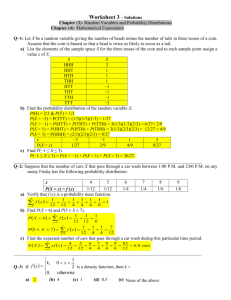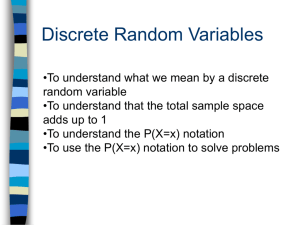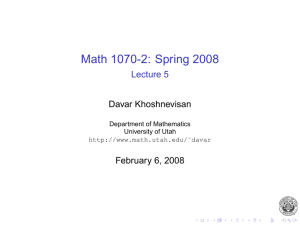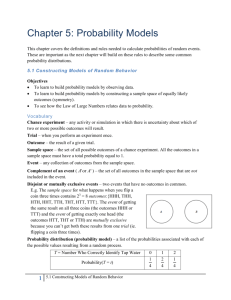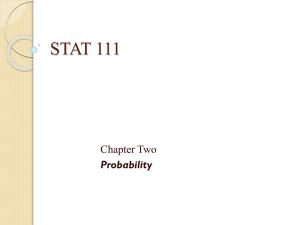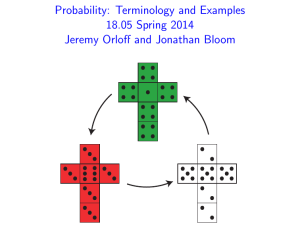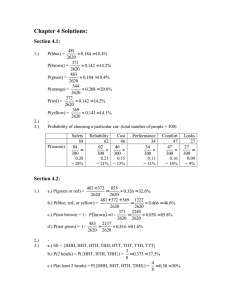probability and distribution function
advertisement
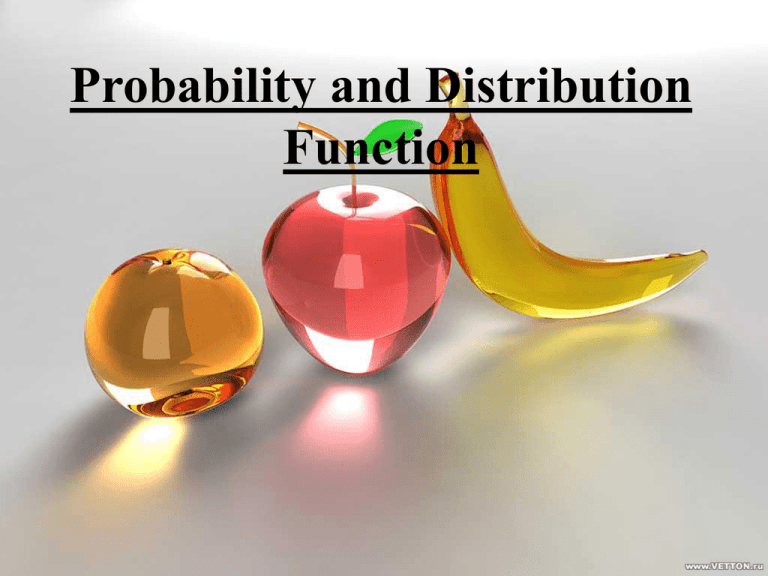
Probability and Distribution
Function
Random Experiment: An experiment whose
outcome is uncertain.
Sample Space (S): A set of all elementary
outcomes of an experiment.
E.g. 1. A coin is tossed; S = {H, T}
2. A die is rolled; S = {1, 2, 3, 4, 5, 6}
3. A Coin is tossed twice; S = {HH, HT, TH,
TT}
Sample points: Elements of a sample space.
Event: A phenomenon that may or may not be
observed as a result of the experiment. Also, defined
as a subset of sample space.
E.g. a) In tossing of a coin,
A: The coin falls on Head; A = {H}
b) In tossing a coin thrice,
S = {TTT, HTT, THT, TTH, THH, HHT, HTH, HHH}
B: Head on all tosses B = {HHH}
C: Heads and Tails are alternate
C = {HTH, THT}
D: At most two heads
D = {TTT, HTT, THT, TTH, THH, HHT, HTH}
Probability
If an experiment can result into any one of n
mutually exclusive and equally likely
outcomes of which m are favourable to an
event A, then probability of an event A is
given by
m
P(A) =
n
Properties of Probability
1. 0 < P(A) < 1
2. If m outcomes out of n are favourable to
event A, remaining (n-m) outcomes will be
favourable to Ā, so that P(A) = m/n and
P(Ā) = (n-m)/n
Thus P(A) + P(Ā) = 1
Probability Distribution
If a coin is tossed thrice, the sample space
S = {TTT, HTT, THT, TTH, THH, HHT, HTH, HHH}
Let X: Number of heads
Value of X
Outcomes
Probability
0
TTT
1/8
1
TTH, THT, HTT
3/8
2
HHT, HTH, THH
3/8
3
HHH
1/8
Here X assumes different values depending upon the
occurrence of the number of heads. Hence X will be
called as a RANDOM VARIABLE.
When X is listed with the corresponding values of
probabilities is called as a PROBABILITY
DISTRIBUTION of the random variable X.
X is called as a DISCRETE Random variable as it
assumes INTEGER values only.
The distribution can be written as:
X: 0
1
2
P(X=x): 1/8
3/8
3/8
3
1/8
It is also called as Probability Mass
Function (PMF), and can also be written as
P(x).
0 < P(x) < 1 for each x
Sum of all probabilities is always = 1
Expectation and Variance
E(X) = ΣxP(x)
V(X) =
2
Σx P(x)
–
2
[E(X)]
NORMAL DISTRIBUTION
The most widely used continuous probability density
function of a continuous random variable X is given
by
1
f ( x)
e
2
=0
1
2
x
2 2
; x , , 0
; otherwise
The random variable in this case is said to follow a
Normal Distribution with parameters μ and σ.
The graph of y = f(x) is known as the normal
curve.
PROPERTIES OF NORMAL DISTRIBUTION AND
NORMAL CURVE
Mean = median = mode = μ.
Standard deviation = σ.
As x moves away from μ, the curve comes closer to
the x-axis and extends till infinity on both sides
without touching the x-axis.
The normal curve is a symmetric bell-shaped curve;
symmetric about x = μ.
The total area under the normal curve = 1.
A normal variate with mean (μ) = 0 and standard
deviation (σ) = 1 is known as standard normal variate
and is usually denoted by Z.
Curve of a Standard Normal Variate
Area under the standard normal
curve
The area to the left of Z = 0 is same as that
to the right of Z = 0 i.e. 50% or 0.5.
To convert a normal variable X to a standard
normal variable Z, we use the following
transformation: Z = X – μ
σ
P(Z < Z0) = Area to the left of Z0
P(Z > Z1) = Area to the right of Z1
P(Z2 < Z < Z3) = Area between Z2 and Z3

